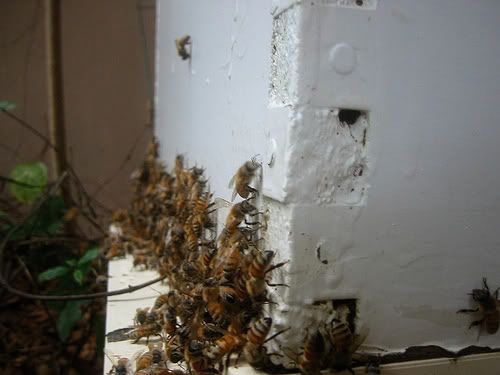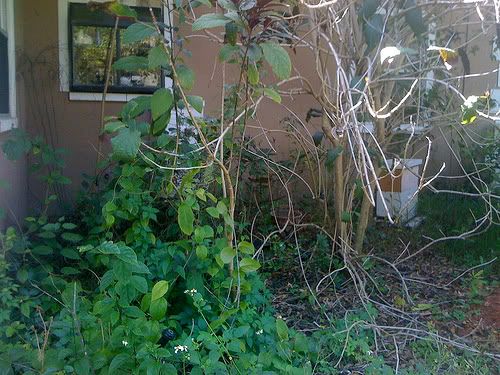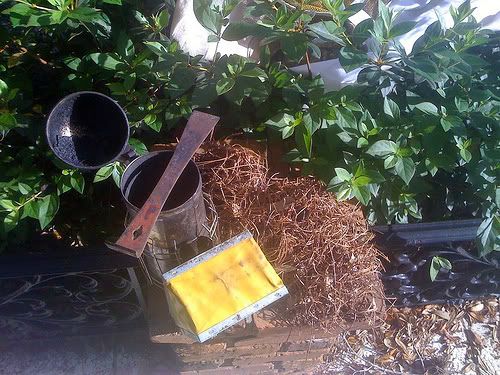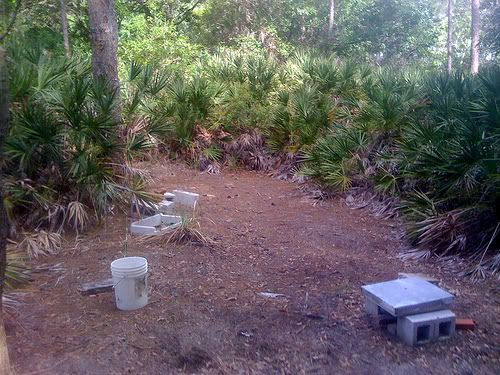Honey Harvest
I finally got around to harvesting everything that had been stored up from all of 2007. The italian hive hadn't drawn out quite what I expected from their new super (added to the bottom, just above the brood chamber) so I only took two supers from it. However, at the russian hive, I was able to take three supers of solidly capped honey. While over there, I managed to get a few decent pictures, ranging from the entrance activity to the bees boiling up following three supers having been removed. There were two bees wrestling at the entrance, probably a guard repelling an intruder. Unfortunately, I wasn't quick enough to get a picture of it, but I'd say the pictures were decent nevertheless.

Notice the single honey bee flying back to the entrance, carrying a load of pollen.

This is the entrance after two supers have been removed. The bees are gradually being repelled and flooding out the entrance.

This is the entrance following all supers having been removed. It's not so much that there were too many bees for the space allowed, but they were being rushed out a bit quickly. I might have used a little too much bee quick.

The last interesting photo, a close up of the bees boiling between the top bars after all the excess supers have been removed. One interesting note is that the center of brood, a box below that, actually corresponds roughly to where the most bees are. That hive's always been a tad odd with how it draws comb.
After driving all the three supers back home, pulling two off of the italian hive, and having them all stacked in the kitchen, the real work began. As usual, it's the relatively annoying process of uncapping each side of the frame, dropping it into the extractor, pouring what piles up after a few frames into the bottling bucket, and repeating. Of course, everything gets sticky and it becomes difficult to maintain a grip on anything. Anyways, with some frustration, the gallons began to just pour out. I actually ran out of lids initially, and then jars, and ended up making a trip to albertson's to pick up two packs of quart jars, with each back having a storage capacity of 3 gallons. All in all, it proved to probably be about a 12 hour process from initial cleaning, to removing the supers, extracting, replacing and cleaning up. Truth be told, I still haven't cleaned out the extractor; giving the bees a bit of a chance to reclaim the spillage first. Of course, that's just a good excuse for being lazy.
After all was said and done, I put three of the extracted supers back onto the russian hive and in the name of laziness, skipped the jacket and smoker, just popping the top off, and placing the supers on one-by-one. I suppose they really are more docile than I give them credit for. A few minutes after that was done, and after I had walked the 20 yards or so back to the driveway, following standing around for several minutes, a bee actually fell out from my pant leg. Hadn't quite expected that one. Oh yeah, I was too lazy for socks as well.

Notice the single honey bee flying back to the entrance, carrying a load of pollen.

This is the entrance after two supers have been removed. The bees are gradually being repelled and flooding out the entrance.

This is the entrance following all supers having been removed. It's not so much that there were too many bees for the space allowed, but they were being rushed out a bit quickly. I might have used a little too much bee quick.

The last interesting photo, a close up of the bees boiling between the top bars after all the excess supers have been removed. One interesting note is that the center of brood, a box below that, actually corresponds roughly to where the most bees are. That hive's always been a tad odd with how it draws comb.
After driving all the three supers back home, pulling two off of the italian hive, and having them all stacked in the kitchen, the real work began. As usual, it's the relatively annoying process of uncapping each side of the frame, dropping it into the extractor, pouring what piles up after a few frames into the bottling bucket, and repeating. Of course, everything gets sticky and it becomes difficult to maintain a grip on anything. Anyways, with some frustration, the gallons began to just pour out. I actually ran out of lids initially, and then jars, and ended up making a trip to albertson's to pick up two packs of quart jars, with each back having a storage capacity of 3 gallons. All in all, it proved to probably be about a 12 hour process from initial cleaning, to removing the supers, extracting, replacing and cleaning up. Truth be told, I still haven't cleaned out the extractor; giving the bees a bit of a chance to reclaim the spillage first. Of course, that's just a good excuse for being lazy.
After all was said and done, I put three of the extracted supers back onto the russian hive and in the name of laziness, skipped the jacket and smoker, just popping the top off, and placing the supers on one-by-one. I suppose they really are more docile than I give them credit for. A few minutes after that was done, and after I had walked the 20 yards or so back to the driveway, following standing around for several minutes, a bee actually fell out from my pant leg. Hadn't quite expected that one. Oh yeah, I was too lazy for socks as well.






